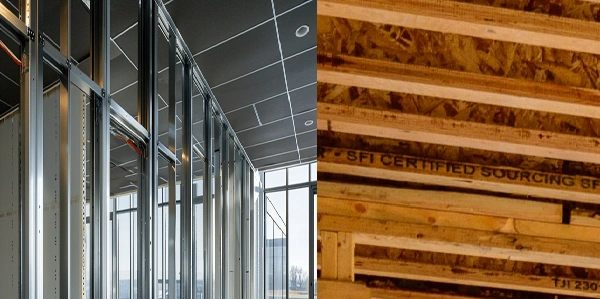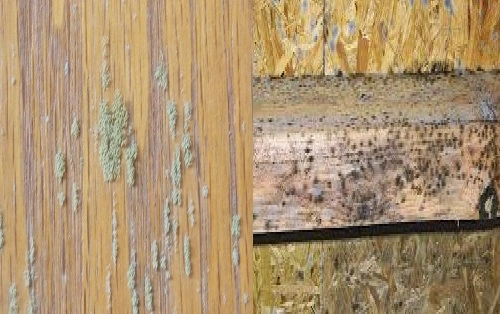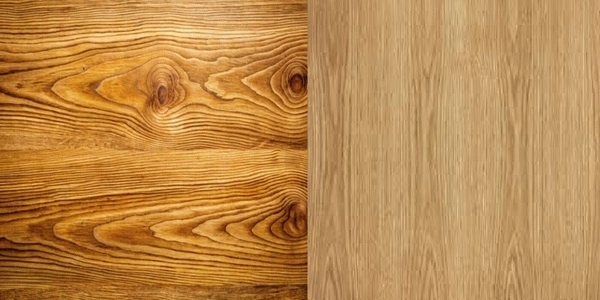When building or remodeling walls in your home or business, choosing between metal stud walls and wood stud walls is a critical decision. Both materials offer distinct advantages and disadvantages, and understanding their characteristics can help you select the best option for your specific project.
This article explores the differences between metal and wood studs, including their cost, durability, installation, and ideal applications, so you can make an informed choice.
What Are Metal Stud Walls?
Metal stud walls are constructed using steel framing instead of traditional wood. These studs are typically made from galvanized steel and are lightweight, durable, and resistant to moisture and pests.
Key Characteristics of Metal Stud Walls:
1. Material: Made of cold-formed, galvanized steel, which resists rust and corrosion.
2. Installation: Requires screws instead of nails and often needs specialized tools.
3. Common Uses: Primarily used in commercial construction, but increasingly popular in residential projects.
What Are Wood Stud Walls?
Wood stud walls are constructed using natural wood as the framing material. They have been the traditional choice in residential construction for decades and are highly versatile.
Key Characteristics of Wood Stud Walls:
1. Material: Typically made from dimensional lumber, such as pine or fir.
2. Installation: Easy to cut and fasten with standard tools like hammers and nails.
3. Common Uses: Predominantly used in residential construction for interior and exterior walls.
Comparison of Metal and Wood Stud Walls
| Feature | Metal Stud Wall | Wood Stud Wall |
|---|---|---|
| Cost | Generally more expensive upfront | More affordable, especially for small projects |
| Durability | Resistant to moisture, pests, and fire | Prone to rot, warping, and insect damage if untreated |
| Weight | Lightweight and easier to handle | Heavier, requiring more effort to move |
| Strength | High tensile strength, suitable for tall walls | Strong and sturdy, ideal for load-bearing walls |
| Ease of Installation | Requires screws and special tools | Easier to cut, nail, and modify |
| Moisture Resistance | Does not absorb moisture | Can rot or warp if exposed to water |
| Thermal Conductivity | Poor insulation; requires additional thermal breaks | Naturally insulates better than metal |
| Sustainability | Recyclable steel; eco-friendly in long term | Renewable resource, biodegradable |
| Soundproofing | Requires additional insulation for noise reduction | Better natural sound-dampening properties |
| Fire Resistance | Non-combustible, ideal for fire-prone areas | Combustible; requires fire-rated treatments for safety |
Advantages of Metal Stud Walls
1. Durability: Metal studs do not warp, rot, or shrink over time. They are immune to termites and other pests, making them ideal for long-lasting structures.
2. Moisture and Fire Resistance: Steel framing is non-combustible and resistant to moisture, making it an excellent choice for areas prone to humidity or fire hazards.
3. Lightweight: Metal studs are lightweight, making them easier to transport and handle during construction.
4. Eco-Friendly: Made from recycled materials, metal studs are 100% recyclable and contribute to sustainable building practices.
5. Ideal for Tall Walls: Metal studs offer better support for taller walls, especially in commercial spaces like offices or warehouses.
Disadvantages of Metal Stud Walls
1. Cost: Metal studs are generally more expensive than wood studs, both in terms of material and installation costs.
2. Thermal Conductivity: Metal is a poor insulator and can transfer heat or cold, requiring additional insulation to meet energy efficiency standards.
3. Complex Installation: Requires special tools and fasteners, which can add to labor costs and installation time.
4. Limited Load-Bearing Capacity: While durable, metal studs are not as strong as wood for heavy load-bearing walls, requiring additional reinforcement.
Advantages of Wood Stud Walls
1. Affordability: Wood studs are generally more cost-effective, especially for residential construction or small-scale projects.
2. Ease of Installation: Wood is easy to cut, nail, and modify on-site with basic tools, making it accessible for DIYers and contractors alike.
3. Better Insulation: Wood provides natural thermal insulation, reducing the need for additional materials to meet energy codes.
4. Availability: Readily available in various sizes and grades at local lumber yards and hardware stores.
5. Load-Bearing Strength: Ideal for structural walls, wood studs can handle heavy loads, including roof and floor systems.
Disadvantages of Wood Stud Walls
1. Vulnerability to Moisture and Pests: Wood is susceptible to rot, mold, and termite damage if not treated or maintained properly.
2. Fire Hazard: Wood is combustible and requires additional treatments or fire-resistant drywall to improve safety.
3. Warping and Shrinking: Changes in humidity and temperature can cause wood to warp, crack, or shrink over time, potentially compromising the structure.
4. Environmental Impact: While wood is a renewable resource, improper logging practices can lead to deforestation and habitat loss.
When to Choose Metal Stud Walls?
1. Commercial Buildings: Ideal for office spaces, retail stores, and other commercial applications due to their durability and fire resistance.
2. Moisture-Prone Areas: Use metal studs in basements, bathrooms, or coastal environments where moisture is a concern.
3. Tall or Non-Load-Bearing Walls: Metal studs are excellent for partitions and tall walls that don’t need to support heavy loads.
When to Choose Wood Stud Walls?
1. Residential Construction: Perfect for homes due to their affordability, ease of use, and load-bearing capacity.
2. Small-Scale DIY Projects: For quick and cost-effective wall framing, wood studs are easier to work with and widely available.
3. Energy Efficiency: Choose wood studs in climates where natural insulation is a priority.
Cost Comparison
1. Metal Studs:
- Material costs are higher, ranging from $2 to $4 per stud, depending on the gauge and length.
- Labor costs can also increase due to specialized tools and skills required.
2. Wood Studs:
- Typically cost $1.50 to $3 per stud for common sizes like 2x4s or 2x6s.
- Easier and cheaper to install, reducing overall project costs.
Conclusion
Both metal stud walls and wood stud walls offer unique benefits, and the choice ultimately depends on the specifics of your project. Metal studs excel in durability, fire resistance, and moisture tolerance, making them ideal for commercial spaces and areas prone to environmental challenges. On the other hand, wood studs are cost-effective, easy to work with, and perfect for residential construction or projects that require load-bearing strength.
Consider your budget, environmental conditions, and the intended use of the space when deciding between these two options. With the right material, you can ensure your walls are strong, efficient, and long-lasting.


